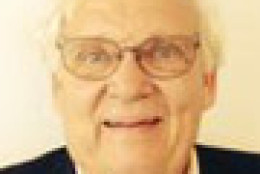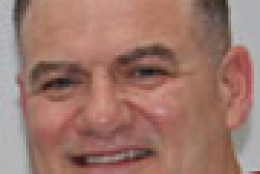Navy
-
The Navy is scrapping a plan to overhaul one of its 11 aircraft carriers. The Defense Department says doing that frees up money to spend on the Littoral Combat Ship program. Everett Pyatt is leader of the Project for Defense Management and Acquisition Leadership Program at the McCain Institute and a former assistant secretary of the Navy. He's writing in Real Clear Defense about the Navy's budget plans.
May 07, 2014 -
Imagine cleaning out your closets and finding something more than 100 years old that you never knew existed. That's exactly what happened to the Naval History and Heritage Command in Washington, D.C. Hidden on a closet shelf were two boxes filled with artifacts from the Spanish-American War. Federal News Radio Web Manager Julia Ziegler and Web Editor Michael O'Connell told Federal Drive hosts Tom Temin and Emily Kopp about the glass plate photos found in the boxes. Read Federal News Radio's related article and view photos.
May 02, 2014 -
A few hours change in sleep patterns might not seem like a big deal. But for members of the Navy's silent service, it could have major implications. The Navy has given commanders the green light to change submariners' sleep schedules, so that they more closely resemble life above the ocean's service. Now, sailors' work days will begin every 24 hours, instead of every 18 hours. Lt. Tim Hawkins, a spokesman for the submarine force, told Federal Drive hosts Tom Temin and Emily Kopp what prompted the changes.
April 30, 2014 -
Need a syringe or an oil cap? Press "print." The Navy has installed a 3-D printer on an assault ship for just those types of emergencies.The pilot test is aboard the USS Essex, an amphibious assault ship. Lt. Ben Kohlmann, a member of the Chief of Naval Operation's Rapid Innovation Cell, is one of the officers responsible for putting the printer in the sailors' hands. He told Federal Drive hosts Tom Temin and Emily Kopp how the 3-D printer got on board.
April 28, 2014 -
Dennis McGinn, assistant secretary of the Navy for energy, installations and environment, says the pursuit of renewable energy is not just about the Navy "going green." It supports the mission.
April 23, 2014 -
Navy says the Defense Production Act and a new partnership with USDA will help it generate several hundred million gallons per year of U.S.-based biofuel. The solicitations it plans to issue over the next year are a key stepping stone to the Navy's goal of getting half its energy from alternative sources by 2020.
April 23, 2014 -
The Navy says it will move forward this year to create two new acquisition vehicles to ensure it has a stable supply of advanced biofuels. And as Federal News Radio's DoD reporter Jared Serbu reports, the service says it won't be any more expensive than petroleum products.
April 22, 2014 -
Renewable energy is a big priority for the Department of the Navy. The ultimate renewable energy source for a ship at sea is of course seawater. Now the U.S. Naval Research Laboratory is making big steps toward using seawater for fuel. Dr. Heather Willauer, research chemist at the Naval Research Laboratory, tells In Depth with Francis Rose what they've found on the path to making seawater fuel the Navy's fleet.
April 22, 2014 -
The Naval Air Systems Command's acquisition practices are laden with so much unnecessary costs that its commander worries about its ability to meet its mission to the fleet a few years from now. NAVAIR's commander said it's time to rethink the way it engages the acquisition system and with industry.
April 10, 2014 -
The Navy has a unique way it approaches the health and wellness of its sailors. All food aboard ships is developed and approved by a triad of people. The special group consists of an executive chef, a dietitian, and a subject matter expert. Danny King, commander of the Supply Corps for the Navy and director of the Navy Food Service, spoke with Federal Drive Host Emily Kopp at the Sea Air Space Exposition. View photos and listen to more of our interviews from the expo.
April 07, 2014 -
The Navy continues to change the way it thinks about energy consumption. Navy Secretary Ray Mabus recently outlined several energy goals for the next six years. They include reducing petroleum used afloat and increasing alternative energy use ashore. Much of the responsibility for that plan falls to Vice Admiral Philip Hart Cullom, the Deputy Chief of Naval Operations for Fleet Readiness and Logistics. He spoke with Federal Drive Host Emily Kopp at the Sea Air Space Exposition. View photos and listen to more of our interviews from the expo.
April 07, 2014 -
On any given day, the Department of the Navy is the size of the largest two or three companies in the United States. With hundreds of thousands of people and a network of installations and other assets worldwide, it's a real challenge to manage. Right now, that job falls to Adm. Jonathan Greenert, the chief of Naval Operations. He spoke with Federal Drive co-host Emily Kopp at the Sea Air Space Exposition. View photos and listen to more of our interviews from the expo.
April 07, 2014 -
The Navy is long overdue to move away from its legacy network known as the Navy-Marine Corps Intranet. Now, brass says it intends to move its enterprise IT network onto its new contract, known as NGEN, by the end of September. Listen to Federal News Radio DoD Reporter Jared Serbu's audio report or read Jared's related article .
April 07, 2014 -
After dealing with a bid protest, meeting the timeline will require the Navy and its prime vendor to move quickly. The new schedule accelerates the original transition schedule by several months.
April 07, 2014 -
The Littoral Combat Ship program is in turmoil as Defense Secretary Chuck Hagel sets up a task force to look at alternatives to the LCS. That task force's recommendations could include a modified LCS system, an alternative system or continuing with the LCS as-is. Rep. Rodney Frelinghuysen, chairman of the House Appropriations Defense Subcommittee, heard from leaders across the Navy and Marine Corps. In our Congressional Spotlight, he explains his concerns about the LCS.
March 31, 2014













